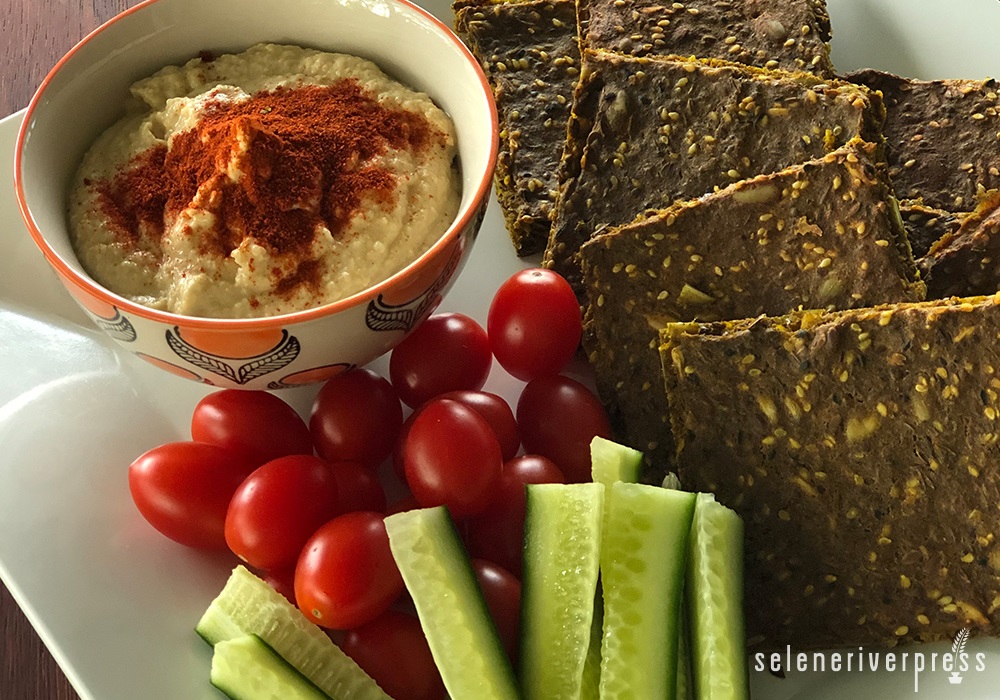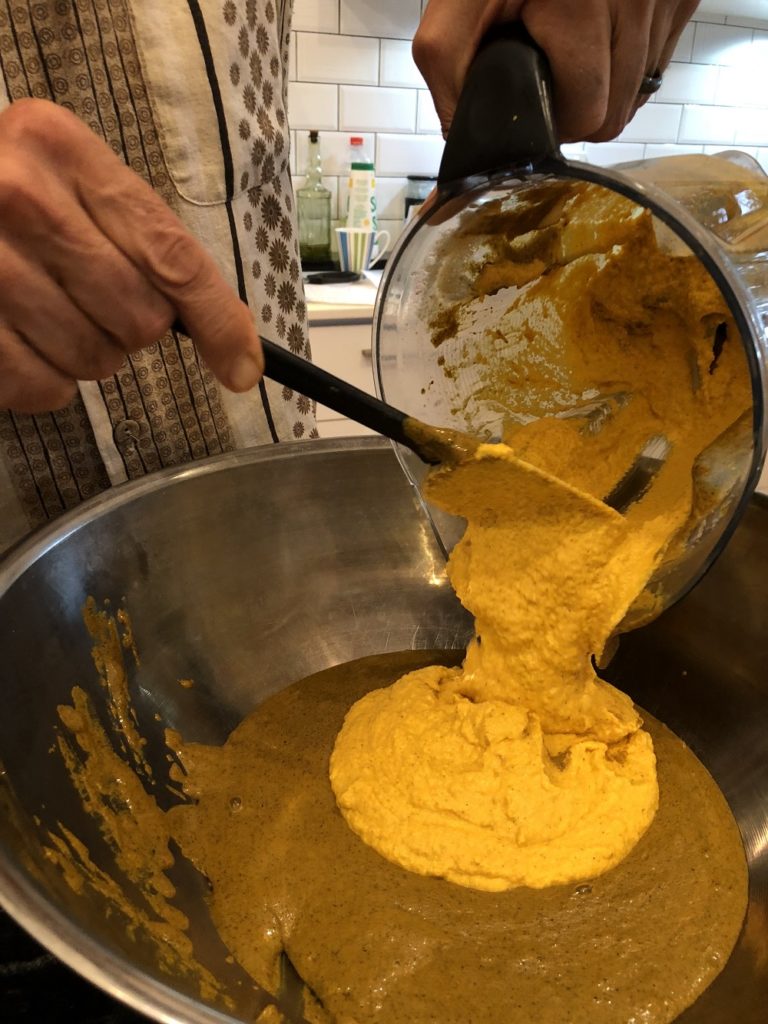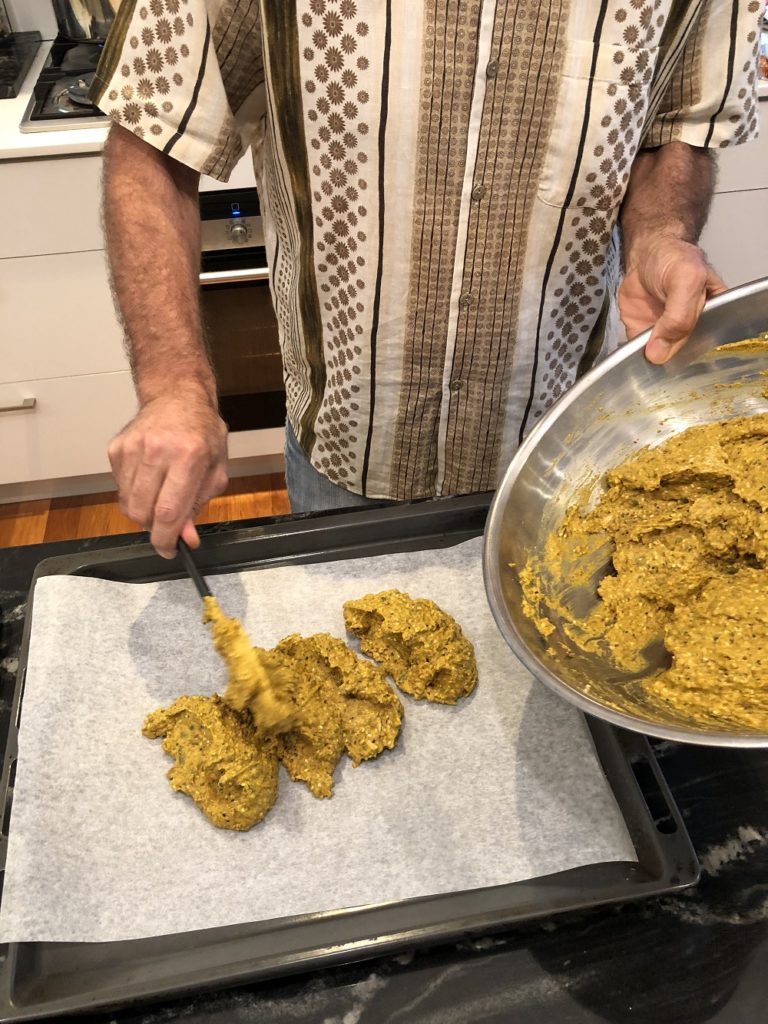Turmeric—especially its yellow pigment, curcumin—has become a popular supplement in recent years, and for good reason. Rarely does an herb exert its health benefits so broadly and effectively throughout the whole body. If you’re looking for general preventative and health maintenance strategies, or if you have specialized health concerns, I recommend it daily.
The clinical trial data and other scientific research touting the benefits of turmeric is truly outstanding. However, curcumin has poor bioavailability, which means we need high doses of turmeric to receive the health benefits. Not surprisingly then, in recent years a plethora of bioavailability-enhanced turmeric supplements have poured into the market, all with their patented and proprietary technologies.
As an herbalist and clinician, I’m well aware that we can’t always trust or rely on the quality of retail supplements. On the other hand, high-quality, professional-grade turmeric supplements can be expensive. We experience the best health benefits of turmeric only when we integrate it into our lifestyle and take it regularly over the course of many years—even a lifetime. And the expense of this supplement this can create an unreasonable economic burden, which may be a deterrent to regular consumption.
This is where my turmeric flatbread story begins!
I’ve recommended to my clients that they get more herbs and spices in their diets for years. But I haven’t had much success, particularly with turmeric. Simply put, it’s just not found in many staples of the Western diet. This prompted me to start playing around in the kitchen with popular foods such as crackers and flatbreads, which can be eaten daily.
Turmeric is traditionally combined with other spices, one of them being fenugreek seed. Somewhat opportunely, current science tells us that fenugreek seed does the very best job in improving the bioavailability of curcumin. In fact, fenugreek seed significantly outperforms everything else, including black pepper. Fenugreek seed also supports digestive and metabolic health, assists convalescence, and helps with difficult lactation.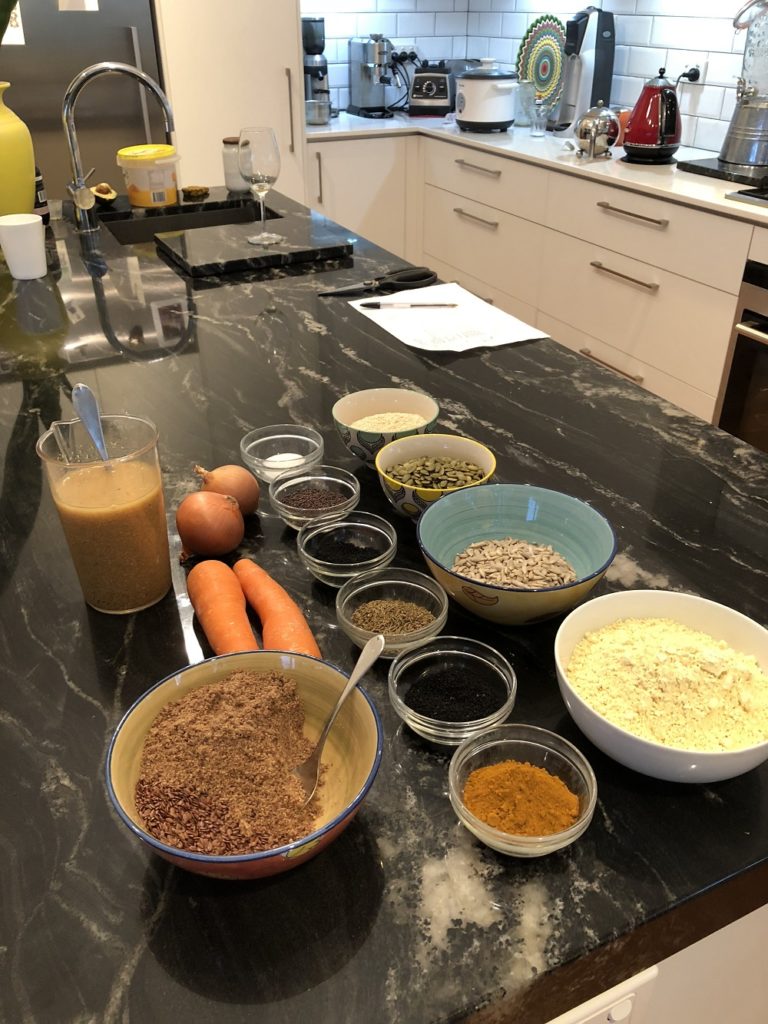
Fenugreek seeds contain high amounts of soluble fiber, which makes it well adapted to arid climates. Waiting in the soil for the right conditions, they soak up to nearly ten times their weight in water, thus providing the emerging seedling a better chance of survival. It’s this soluble fiber that creates the magic in my flatbread!
Soaking the fenugreek seeds overnight in water and then blending them at high speed creates a thick emulsion. The act of blending the turmeric into this emulsion creates a natural colloid (suspension) of the curcumin. By the time you eat the dried flatbread, the curcumin will be mucoadhesive in the small intestine, which prevents it from becoming enzymatically altered or degraded when your body absorbs it.
Curcumin is lipophilic (meaning it dissolves in fats) and easily crosses cell membranes. It has a natural affinity for albumin, the major transport protein in our blood, which helps the curcumin circulate throughout the vascular system. But curcumin also has a natural affinity to other human proteins. This powerful substance helps cells and tissues achieve optimal health and performance. Imagine curcumin as a small mechanism in a clock that helps all the cogs and springs keep perfect time—now you have a good idea of what it does for the human body.
I wanted to create a broadly appealing food that’s free of many ingredients people are sensitive to. In that, fenugreek seeds offer another significant advantage to this flatbread recipe: it acts as a binder to hold the flatbread together, which means you don’t need eggs or other traditional binders. The seeds also give the flatbread a fantastic texture.
Finally, I wanted to use ingredients that not only have great flavor but also have something to offer in terms of nutritional therapy: high in protein and fiber, and rich in phytonutrients. I settled on nigella seeds (“seeds of blessing” or black cumin), flaxseeds, mustard seeds, cumin, pumpkin seeds, sesame seeds, sunflower seeds, and besan (garbanzo bean) flour.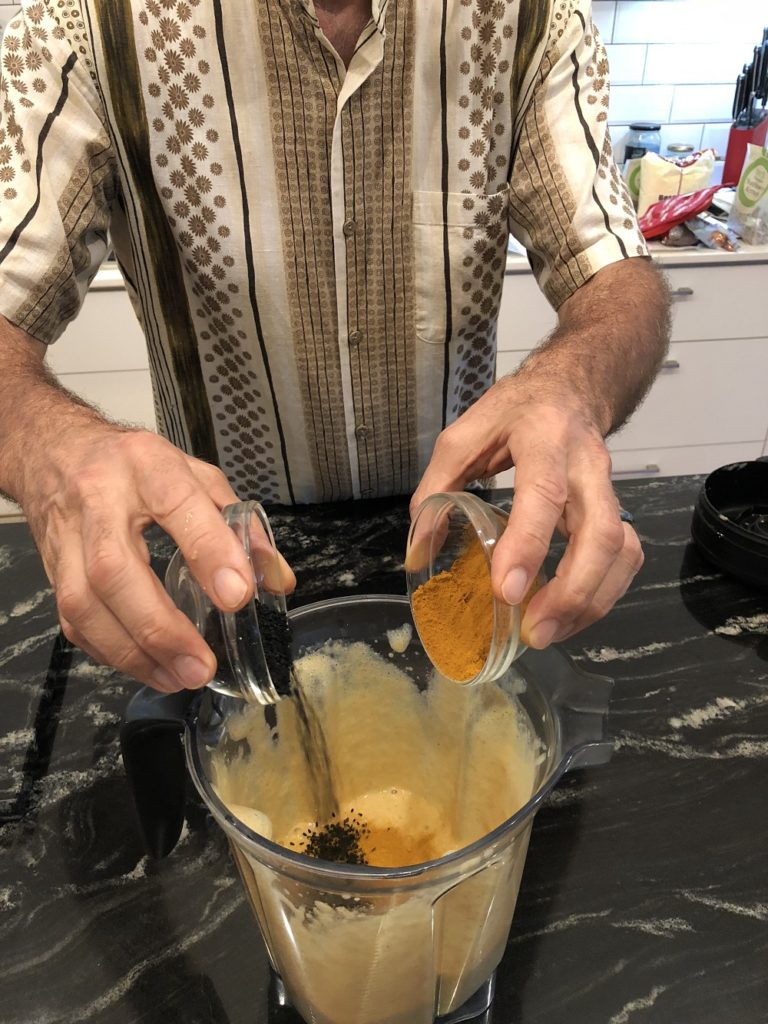
It took me seven versions and many batches to get it right. Some of you may find this recipe a bit challenging. It involves lots of steps and an investment in uncommon ingredients. However, once you have the ingredients and start baking it regularly, you can easily incorporate it into your diet and start reaping the health benefits: improved cellular health and protection, metabolic well-being (blood sugar stability and lipid levels), microbiota balance, and healthy aging, to name just a few.
Turmeric Flatbread
—These are delicious with lashings of butter, but I also love them with humus and avocado or as a replacement for bread or crackers. Or be adventurous and crumble it over a green salad. You can even eat it plain as a side to almost any meal. I recommend 1–2 squares per day.
Enjoy!
Ingredients
2 level tablespoons (40 grams) organic whole fenugreek seed
20 oz. (600 ml) water, plus an additional 2 oz. (60 ml)
2 heaped tablespoons (20 grams) organic turmeric powder (see turmeric note below)
2 heaped tablespoons (40 grams) organic nigella seed, divided
2 oz. (60 ml) sesame seed oil or olive oil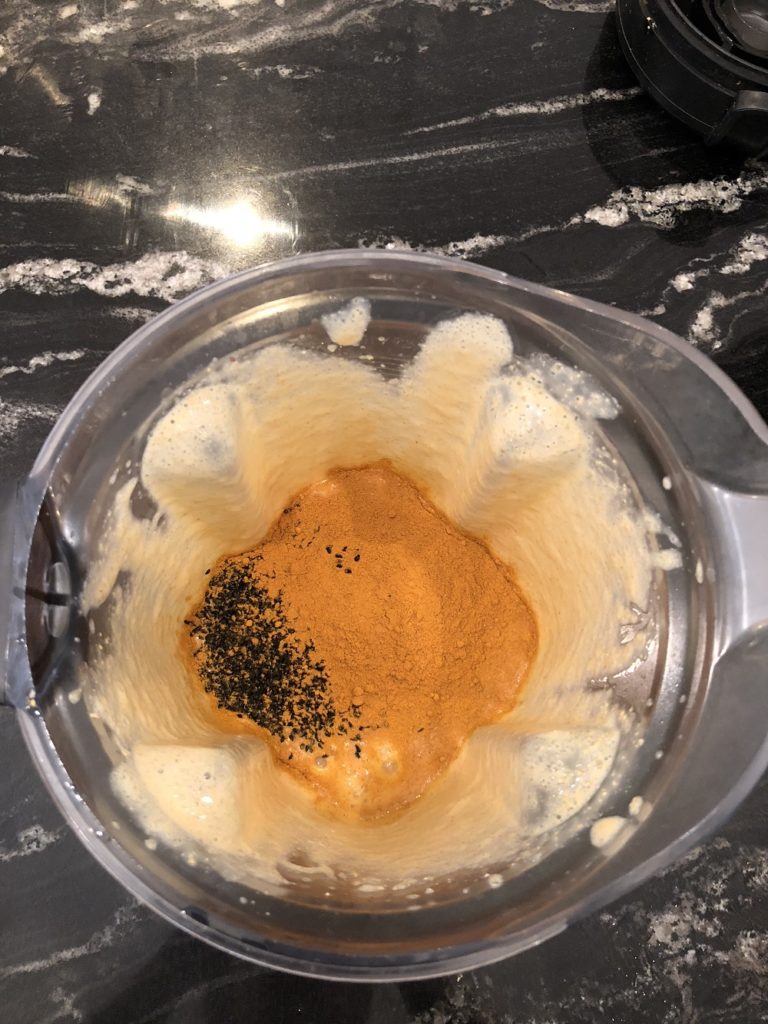
2–3 (about 200 grams) medium yellow onions (also known as brown onions), roughly chopped
2–3 (about 300 grams) large carrots, chopped or grated
2 oz. (60 ml) sesame seed oil or olive oil
2 cups (260 grams) organic besan (garbanzo bean) flour (organic because conventional besan is particularly high in glyphosate)
4 level tablespoons (20 grams) cumin seed
2 heaped tablespoons (20 grams) mustard seed
1 cup (160 grams) pumpkin seed
1 cup (100 grams) sesame seed
1 cup (100 grams) sunflower seeds
1 cup (140 grams) whole brown flax/linseed seed, half of it finely ground (see flaxseed note below)
2 teaspoons salt
Special equipment:
2 large baking trays, with a baking area of roughly 15×12 inches (38×30 cm) each
Parchment paper
Large metal spatula
Spice grinder
High-speed blender (such as a Vitamix)
Note: If you do not have a high-speed blender, you will need a regular blender and a food processor
Instructions
- Soak the fenugreek: Place fenugreek seeds and 20 oz. (600 ml) of the water in a medium bowl. Stir well, cover, and let soak on the counter overnight (minimum 6 hours). No need to refrigerate. (If you have a spice or old coffee grinder, you may grind the seeds first to speed up the soaking process.)
- Blitz the fenugreek: Place the soaked fenugreek in a high-speed blender (I use a Vitamix, but you may use a regular blender for this step). Start slow and gradually increase the speed until the texture thickens into a mayonnaise-like consistency. This may take a few minutes.
- Incorporate turmeric and nigella: Add turmeric powder and 1 tablespoon (20 grams) of the nigella seeds to the fenugreek. Blend on high speed 3–5 minutes. Add a little water if the consistency becomes too thick. The mixture should be warm to hot when finished and the nigella seeds finely ground. (This step is important because the emulsion created with the turmeric enhances the bioavailability of the curcuminoids. Grinding also increases the bioavailability of the melanin contained in the black coat of the nigella seed, creating a powerful effect on the immune system.)

- Clear the blender: Pour contents of blender into a very large mixing bowl, using a silicon spatula to scrape out as much of the sticky contents as possible. Set bowl aside.
- Puree carrots and onions: If using a high-powered blender: add onions, carrots, oil, and remaining 2 oz. (60 ml) of the water to the blender (you do not need to scrape out the remains of the previous ingredients first). Puree into a smooth, free-flowing thick liquid. Add some of the fenugreek/turmeric mixture if you need more liquid to facilitate blending. If you do not have a high-powered blender: you will need a food processor for this step as a regular blender is not powerful enough. Add the grated carrots and chopped onions first, and process with oil and water to the finest consistency possible. (You may need to incorporate extra water here.)
- Add carrot and onion puree: Using a silicone spatula, scrape out the blended carrot and onion mixture into the mixing bowl with the blended spices. Stir to an even consistency.
- Sift besan flour: Sift the besan flour directly onto the mixture, stirring it in as you go.
- Add remaining ingredients: Finally, add all remaining ingredients: the other half of the nigella (1 tablespoon/20 grams), cumin, mustard, pumpkin, sesame, sunflower, whole and ground flax seeds, and salt. Stir together until an even consistency is achieved.
- Rest the mixture and prepare to bake: Leave the mixture to rest for 10–15 minutes to allow the dough to firm up, though it should still be quite wet. If it is too wet, add more besan flour. Preheat oven to 300°F (150°C). Line baking trays with parchment paper.
- Spread out the dough: Divide the dough equally between the baking trays. Spread it out to cover the surface, achieving an even thickness and a rectangular shape. Use a long metal spatula to smooth it out and give it straight sides. (I flick water onto the dough to make the spatula slide over the surface without sticking. You can also dip the spatula in some water.) If you used a food processor, the dough may not be quite so sticky. This may be the most challenging step of the whole recipe.
- Cut the dough: Once the dough is evenly spread and smoothed out, use a wet knife to score the dough into 20 (4×5) equal portions for each tray. Make sure you use a light touch, scoring the dough all the way through to the paper. Once baked, it will easily break along these lines into equal-sized pieces.
- Bake: Bake in a convection (fan-forced) oven for 50 minutes, or until the desired texture is reached. If you have a conventional oven, up to 60 minutes. You may also need to extend the bake time if you added significantly more water to the mixture.
- Finish: Remove from the oven. When cool enough to handle, break along the score marks to get 20 separate pieces per tray. (Dividing the flatbread into 20 equal pieces makes it easy to calculate the dosage of the herbs.) Store in an airtight container in the fridge for a soft texture.

Nutrition and Dosage Information (per one-piece serving):Calories: 126
Protein: 4.88 grams
Total Fiber: 3.35 grams
Turmeric: 0.5 gram
Curcuminoids: 25 mg
Fenugreek: 1 gram
Nigella: 1 gram
Flaxseed: 3.5 grams
Turmeric notes: I purchase organic turmeric powder that is standardized to 5 percent curcuminoids. A total of 20 grams of turmeric per batch yields 25 mg of bioavailability-enhanced curcuminoids in each serving (eating 2 pieces per day is a genuinely good therapeutic dose). To achieve a greater therapeutic effect, increase turmeric to 40 grams (4 heaped tablespoons), providing 50 mg of bioavailability-enhanced curcuminoids. Keep in mind that this does make for a much stronger taste
Flax/linseed notes: Avoid store-bought ground flax seed if possible as it goes rancid very quickly. However, if you don’t own a spice grinder, you may use half store-bought ground flax and half whole flax seeds. Always store flax in the fridge.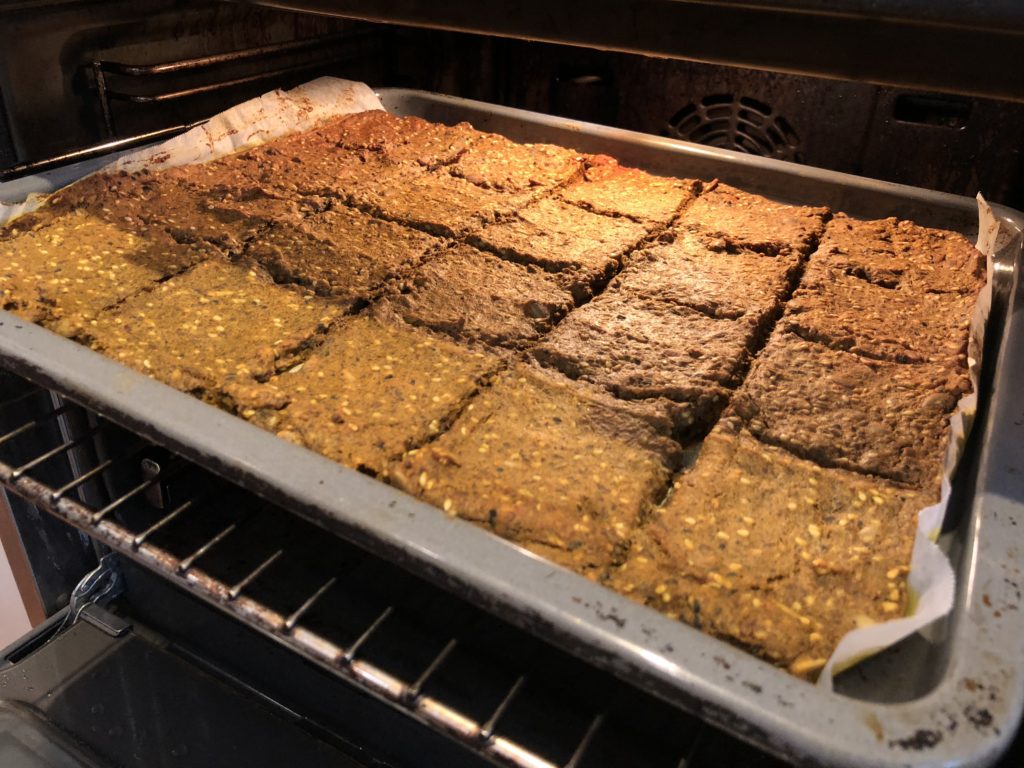
Ingredient suppliers: I recommend purchasing the spices from an online Indian food store. That way you can get everything you need in the one go! The following websites offer organic ingredients, but with a little searching you may find local options that serve you better.
PureIndianFoods.com
IShopIndian.com
Videcpro.com
© Lee Carroll 2018
Images from Lee Carroll.


